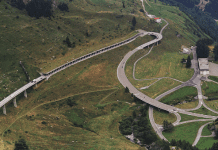Cities typically have the following arrangement: in the middle there is a cluster of high rise buildings. And then, as you move to the suburbs, the density reduces. Historically, the reason for high-rise buildings was the fact that renting space in the middle of cities was so expensive. It made more sense to build tall.
But it turns out that there are more benefits besides cost saving. Companies that work in high-rise buildings also appear to be more productive. And not just because they are more successful and can afford it.
European Cities Are Having A Skyscraper Moment
This news comes at an interesting time. European cities are currently going through a skyscraper boom. The city of London is barely recognisable compared to twenty years ago. The only constant is Tower 42 and the stock exchange building, and even those look different.
London isn’t alone. There are now more than 602 buildings higher than 200 meters around the world, which is more than double the number that there were in 2000.
High-rise buildings tend to draw all kinds of scepticism and criticism. Some people see them as gleaming symbols of modernity, constructed from cut and bent steel reinforcement. Others see them as glass eyesores that should have no place in human cities.
Productivity Improvements
Now, thoughm, businesses are wondering whether they might offer their workers the ability to work more effectively. In a new study from the SERC discussion paper, researchers at the University of Amsterdam ask whether height can actually change the way that people work.
The researchers don’t think it’s the views – although that might help. They think that it has a lot to do with the fact that workers are better able to discuss ideas with colleagues from other businesses that inhabit the same building. Often, related firms will all rent floors in office towers and then deliberately create communal spaces where workers can share ideas. This cross-fertilisation as they see it, leads to more ideas and a bigger talent pool.
Working higher may also offer prestige benefits that help companies attract high-quality workers. The prospect of working high above everyone is appealing to many high-flyers. It can subtly influence their decision-making.
The benefits of going higher, however, tend to trail off once you get past around 240 metres. This fact might explain why relatively few firms build buildings taller than this. It does happen, but it is rare. The sweet spot appears to be somewhere a little over 200 meters.
These results, of course, depend heavily on the type of statistical models you apply. But they are interesting. It seems that companies that go higher tend to lock in their success, thanks to the increased output of their workers versus their rivals.
The economic cost of building higher, however, is considerable. It still only really makes sense to do it right in the middle of big cities close to the center of the transport network. So don’t expect to see any high-rises on the edge of town any time soon.









































